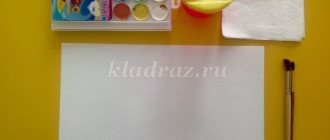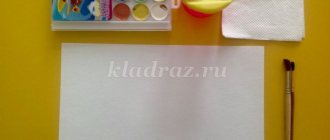Summary of OD in the senior group of kindergarten on the topic “Autumn. Signs of autumn. Leaf fall"
Educational activities for children of the senior group “Autumn.
Signs of autumn. Leaf fall" Goal: Expanding vocabulary on the topic.
Clarifying children's knowledge about autumn. Formation of the ability to use singular and plural nouns. Development of the word-formation function of speech based on children’s exercises in using nouns with diminutive suffixes. Progress of educational activities
I. Organizational moment. (Approach the windows). Conversation on issues. What is the weather today? Why are people dressed in raincoats and jackets? What do you call a small cloak? (Cloaker). A jacket? (Jacket). Umbrella? (Umbrella). What do people have in their hands? Why do they need umbrellas? What are the trees like? What sky? Conclusion: today is a cloudy, rainy day; there is no sun, the sky is covered with clouds. II. Introduction to the topic. 1. Riddle. The fields are empty, the ground is wet, the day is waning. When does this happen? (Autumn). 2. Conversation on the painting “Autumn”. What trees are drawn? What color are the leaves on the trees? Why aren't they green? How can you affectionately call a leaf? (Leaf). Why do the leaves circle in the air? What is this phenomenon called? (Leaf fall). Why is there no sun? What's in the sky? What do you call a small cloud? (Tuchka). What's pouring out of the clouds? Why are there so many birds? Where are they going? What are the names of birds that fly away in autumn? 3. Game with pictures . Select from the presented pictures those that relate to autumn, name what is depicted in it (the wind is blowing, the leaves have turned yellow, there are clouds in the sky, puddles on the ground, etc.). III. Learning new material. 1. Formation of plural and singular nouns. Game “Magic Clock”: on the clock there are pictures in the singular and plural. The arrow stops where one object is drawn. Place the second arrow where many of the same objects are drawn. Name the pictures: leaf - leaves, bird - birds, tree - trees, etc. 2. Work on the proposal. The beginning of the sentence is given, it needs to be completed: In summer the leaves are green, and in autumn ... (yellow, red, ...). In summer the leaves are on the trees, and in the fall they... (fly around and lie on the ground). In summer the sun is hot, and in autumn... (warm). IV. Moving exercise. Children with leaves in their hands perform movements to music (the wind has blown, the leaves are spinning in the wind). Speech therapist . What color are the leaves in your hands? How can you say about them in one word? (Multicolored). V. Consolidation. 1. Speech therapist. Correct me if I make a mistake. — In autumn the weather is hot and stuffy. — In autumn the grass is green. — The sparrows fly south. 2. Game “Wind and Leaves” (breathing development). Children blow on their leaves.
We recommend watching:
Speech therapy lesson in the senior group on the topic: Autumn Lesson summary - excursions in the senior group of kindergarten. Journey to the autumn forest Educational activities in the senior group on the lexical topic “Autumn. Trees" Summary of a modeling lesson in the senior group of a preschool educational institution on the topic: Autumn
Similar articles:
Summary of a lesson in the senior group on an autumn theme based on the fairy tale “Apple” by V. Suteev
Summary of a lesson in the senior group on the topic “Harvest, vegetables, fruits”
Lesson topic: Autumn. Signs of autumn.
Age:
7-9 years
Conclusion:
ZPR of cerebral-organic origin.
Form
of lesson:
individual lesson
Type of lesson:
correction and systematization of knowledge
Topic of lesson:
Autumn. Signs of autumn.
Objectives:
1. Educational:
To consolidate the ability to observe seasonal changes in nature, knowledge of the names of the autumn months and the characteristic signs of autumn.
2.Developing:
Development of elementary mathematical concepts.
Development of coherent oral speech, development of the child’s fine motor skills. 3. Educational:
To cultivate the ability to understand and appreciate the beauty of our native nature.
Arouse interest in self-improvement, self-development, instill interest in classes. 4. Correctional:
Correction of higher mental functions (attention, memory, thinking); adjust and develop spatial concepts;
Methods:
verbal, visual, practical.
Equipment:
illustrative material on the topic, mood emoticons, temporary presentation board.
Progress of the lesson:
I. _ Organizational stage.
-Hello!!!
What's your mood now? Choose from the suggested images to suit your mood. (MOOD SMILES) II. Updating knowledge. Work on the topic.
- Development of temporal representations.
The defectologist reads a poem:
Leaves from trees in the forest are falling off.
The rain is pattering sadly on the roofs.
The bright sky says goodbye to the earth
Gloomy autumn is knocking on the window.
- What time of year do you think the poem is talking about?
- Name the autumn months?
- What can autumn be called in September? (early, golden).
— What can you call autumn in October? (rainy).
— What can you call autumn in November? (late).
- Introductory conversation
– What can you say about the sun in autumn?
(It doesn’t heat well, there are fewer sunny days).
—What is the sky like in autumn? (Gloomy, heavy, cloudy, rainy, cloudy, gray, dark).
— What happens to the trees in the fall? (Leaves: turn yellow, turn red, fall off, dry out. The trees stand bare.)
— What is the name of the phenomenon in nature when leaves fall from trees? (Leaf fall).
— Leaves in autumn, what do they do? (They turn yellow, turn red, dry up, fall, spin, fly, crumble)
— What happens to the grass in the fall? (Dries up, turns yellow, fades)
— What do birds do in the fall? (They fly away to warmer climes)
- Why? What are these birds called? (Migratory)
— What do insects do in the fall? (They hide in old stumps, snags, climb under the bark of trees).
— What do animals do in the fall? (They are preparing for winter. Some go to bed for the whole winter - a bear, a hedgehog, a badger. Others change their skin - a hare, a squirrel, a fox. Still others make supplies for the winter - a squirrel, a hedgehog.)
— What is the weather like in autumn? (Cold, rainy, windy, sometimes snowing.)
- What happens only in autumn? (Harvest, birds flying away, leaves falling.)
III. Development of fine motor skills. Finger gymnastics. Autumn scattered leaves (make wave-like movements with palms) Decorated them with a brush. (make smooth waves with their palms up and down) We will go into the autumn forest, (“walk” with the fingers of both hands) We will collect leaves into bouquets. (they cross their palms with their fingers spread out) A maple leaf, an aspen leaf, (they bend their fingers one by one, starting with the thumb, on both hands at the same time to the name of each leaf) An oak leaf, a mountain ash leaf, a red poplar leaf and jumped down onto the path. (clap hands loudly) IV. Development of hand-eye coordination.
- "Find according to the diagram"
Goal: development of spatial thinking and perception. A drawing is placed in front of the child, which shows a diagram of the path he must take to get to the goal. V. Correction of higher mental functions.
- Game "Pick the sign"
. Children select signs for the word “autumn” using mnemonic pictures.
Autumn (what?) - ... (Cold, rainy, golden, colorful, colorful, fruitful, warm, cloudy, clear, snowy, cheerful, sad, deciduous, etc.)
- The game “What doesn’t happen in autumn?”
Snowdrops do not grow in autumn.
In autumn they don’t swim in the river.
They don't sunbathe in autumn.
In autumn they don't wear fur coats.
VI. Development of elementary mathematical concepts.
- "Right left"
Goal: automation of concepts from right to left
Pictures or postcards depicting several children or animals. The child is asked to answer the question: “Who is sitting to the right of the bear? Name everyone who sits to the left of the bunny,” etc. The same exercise can be done with toys or any objects, placing them on the table.
VII. Development of coherent oral speech. Consolidation of knowledge. “Expand and tell” Goal: Establishing cause-and-effect relationships, developing coherent speech. The student receives a series of pictures on the topic of the lesson. His task is to select picture-episodes in the right order and convey the content of each, thus composing a whole story. VIII. Results of the lesson. Reflection. -What did you and I do today? - Well done, we did a great job today. — Name your associations.
Handing out homework.



